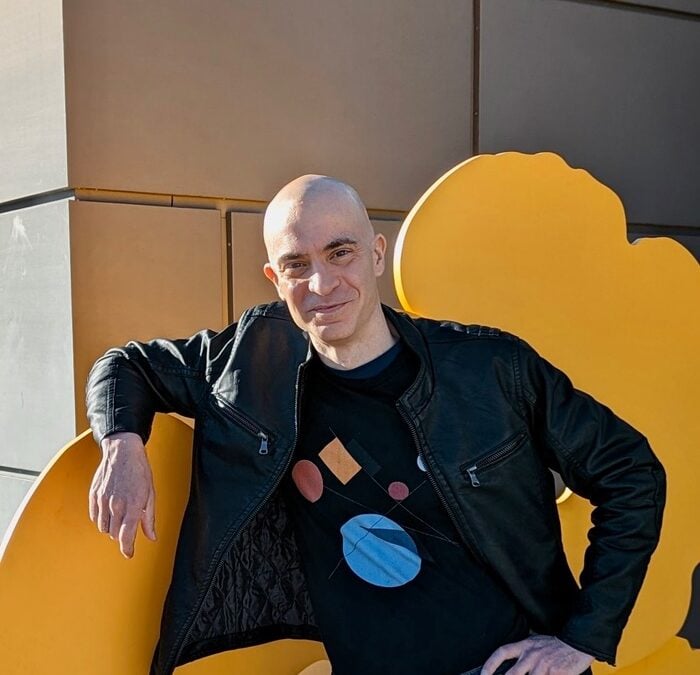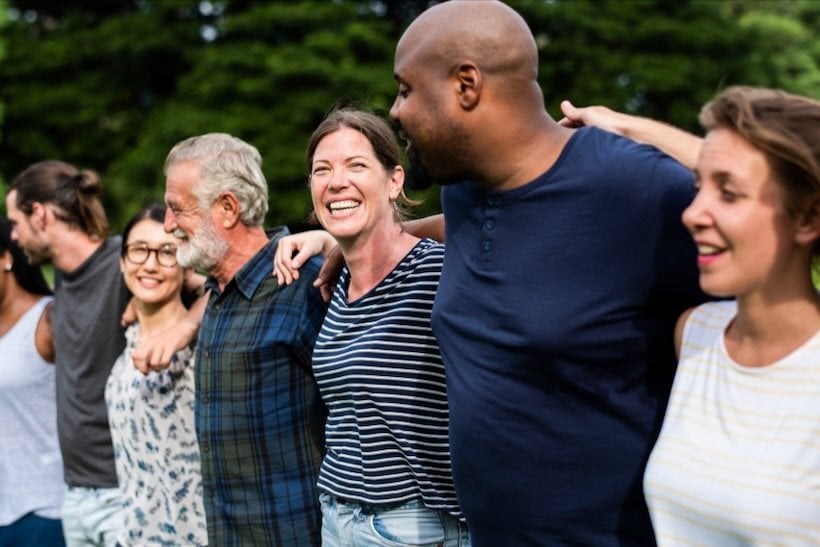My mind swings back and forth as I talk to Dr. Peter Diamandis, founder of the Xprize Foundation and one of the biggest boosters in the high-tech quest for life extension. One moment, he’s giving down-to-earth advice about building muscle and avoiding sugar. The next, he’s flirting with the idea of living inside machines.
How seriously does he take the latter topic? Can technology really let us live forever, I ask.
“That’s a fascinating question. And I try and avoid it as much as possible,” he says, before diving in. “I spend a lot of my time in the world of AI and exponential tech. So do I believe we’re going to be able to, at some point, upload the human mind into the cloud? I do.”

Wide-spanning Enterprises
Diamandis isn’t the first person to espouse such ideas. And a lot of the grandest come from his relationship with futurists such as inventor and business partner Ray Kurzweil. What’s interesting, though, is the balancing act Diamandis strives to achieve between the commonsense and the fantastical, and how he’s built businesses across that spectrum.

These include two privately held companies: Lifeforce and Fountain Life. Each provides testing and products such as supplements or pharmaceuticals that promise to extend healthy life. Lifeforce is pretty accessible, with membership starting at $129/month, and tends to the more-modest end of the spectrum. Fountain Life starts at $3,000 per year and goes up to $90,000. It offers extensive testing, including bone-density measurements, CT scans, and full-body MRIs; treatment regimens with possible life-extending drugs like metformin and rapamycin, and, at the highest level, concierge care by a team of physicians.
Fountain Life also refers patients to overseas clinics for experimental stem cell therapies—something Diamandis aims to bring stateside (if he gets FDA approval) as a director and investor of the publicly traded company Celularity. (In total, Diamandis has invested in more than 100 biotech and health tech companies, he tells me, and he advises more than 30.)

Diamandis’s new book, Longevity: Your Practical Playbook, is largely what it claims to be, with the first three chapters providing tips on diet, exercise, and sleep. Then the fourth talks about uploads—not of your mind (yet) but of 150Gb of imaging, genetic, and blood diagnostic data from annual tests at Fountain Life. The goal is to spot disease in its earliest stages, when the chances for treatment are best.
Though the prices might be out of reach for most people, the basic science isn’t. These are tests any of us might have at some point, if our insurance covers it for a specific reason. But the 2022 book Life Force, where Diamandis plays a supporting author role to the controversial self-help guru Tony Robbins, starts off with futuristic topics like largely untested stem cell therapies.
A Technology Provocateur?
Sci-fi may not be where Diamandis makes the most money, but it is where he makes the most buzz. I had an extra-long chat with Diamandis while researching Worth’s upcoming feature on the panoply of ideas and experiments (and buckets of money) dedicated to extending both lifespan and healthy old age. It got high-tech pretty quickly, with theories on how to live forever.
“[With] the speed at which we’re progressing science, this becomes within the realm of rational thinking inside of the next 30, 40, 50 years,” he says. “Are we going to create immortality through just revitalizing your same body, or we’re going to create immortality through uploading your mind, or we’re going to create your mortality by regrowing your body? I mean, those are questions to be had.”
Not everyone thinks so.
Charles Brenner leads research on diabetes and cancer metabolism at City of Hope. He recounts speaking right after Diamandis at a conference of A4M, the American Academy of Anti-Aging Medicine, last year. “Peter Diamandis went up and said, there’s no limit to human lifespan. We’re going to use AI, stem cells, all this kind of stuff,” recounts Brenner. “And then I tried to bring people down to earth by reminding people that these claims have been around for thousands of years, beginning with Herodotus.”
He’s talking about ancient Greece’s so-called “Father of History” (also perhaps history’s most-gullible reporter), who may have been the one to bring tales of the fountain of youth to the world.
Longevity Escape Velocity
But a lot of science has happened since the fifth century BC. Average lifespans have increased about 20% in Europe (to 79 years) and 40% in Africa (to about 62) just since 1950. Some of this is from common sense: do exercise, don’t smoke. But science has played a key role, too.
“If you imagine you’re a kid born in the 1930s, or 1940s, at that time in human history, we had dramatically suppressed infectious disease. We had things like vaccines, and antibiotics arrived in the 1940s,” says Andrew Steele, author of the book Ageless: The New Science of Getting Older Without Getting Old. Those kids lived longer, on average, than previous generations—often long enough to take advantage of new advancements, such as statins to reduce cholesterol (and deaths from heart disease) and ever-better cancer treatment.
“And so by living longer, as a result of those medical interventions made when you were younger, you’re able to live longer still, when you got to older age,” says Steele. “And those medical interventions, the new ones, were around to save your life when you got there.”
Diamandis imagines this process going to the extreme, with a concept called longevity escape velocity. “My focus right now is, how do I enable myself and those I love and care about, to remain healthy enough to reach escape velocity, to be vital and healthy for an extra 20 or 30 years,” he says. “We’re gonna play this game out, given what’s coming on with AI and quantum computing, quantum chemistry, and gene therapies. All of these technologies are going to become transformative in the next decade, right? We’re not talking about 30 years from now…the speed at which AI is going to transform our world is unfathomable.”
The Search for Hard Proof
That assumes, of course, that there’s no hard limit on the ability of the body to hold on, or at least that it’s radically farther out than current evidence shows.
“It’s evidence based to say you can improve your health trajectory,” says Brenner, who happens to be the same age as Diamandis. “If I commit myself to an improved fitness regimen, or if I were a smoker…or if I were overweight…and I lost weight or I quit smoking, I improved my body composition, I could go from a 62 year old with a relatively poor health trajectory to a 63 or 64 year old with a much better health trajectory.”
“The problem is that there are influencers that talk about stopping aging, reversing aging, turning back the clock, not having to die, not having to age, reaching longevity escape velocity, uploading their brain, and all sorts of things that are not grounded in reality. And they’re very influential,” he says.
One thing both Brenner and Diamandis (and many others) agree on: It’s hard to prove that any treatment enhances longevity. People have always had rather varied lifespans. Ramses II lived to at least 90. That was over 3000 years ago, and it still beats the average lifespan in the wealthiest countries today. With so many genetic, economic, behavioral, and environmental factors affecting lifespan, it’s hard to pinpoint any one factor that could be making a difference—to pick out the signal from the noise.
There have been efforts to measure “biological age” at the cellular level. Perhaps the most popular of these biomarker tests is the epigenetic clock, which measures how effectively cells read DNA to make proteins as they age. Brenner calls such tests problematic.
“To me, you can tell whether you’re aging well on the basis of whether you can still climb stairs and play with your kids or grandkids,” he says. “Some of the biomarkers and age tests that are being used to evaluate interventions can provide data that are less than useful.”
Xprize for Longevity
Diamandis has a track record of making unlikely things happen. In 1996, he raised a $10-million purse to award the first team that could fly a three-person vehicle to space twice within two weeks. After eight years and $100 million of investment by 26 teams, what became the Ansari Xprize was awarded to Paul Allen and Burt Rutan’s Mojave Aerospace Ventures. Their technology now powers Virgin Galactic’s rocket plane for space tourists.
(It’s been less than a smash success, though. It took nearly 20 years, and one fatal test crash, to commence suborbital commercial flights, of which there have been five. Virgin Galactic has never made a profit, the stock is down, and it’s just announced that it will abandon use of the Ansari-derived craft.)
The Xprize foundation has completed 16 more competitions since Ansari, with companies like Shell or tycoons like Elon Musk funding tech for such efforts as developing cheap Covid tests, removing CO2 from the atmosphere, coding educational software, and building deep-sea robots. Five new competitions are currently underway.
The newest and biggest (by a hair) is the $101 million Healthspan Prize, which launched in November. It will fund awards to teams that can show, in clinical trials of 65-to-80-year-olds, significant improvement of muscle, cognitive, and immune function. Over 200 teams from about 40 countries have preregistered so far. “The question is, what’s out there that’s revolutionary, not incremental? I think this is what we’re going to see coming out of the Healthspan Xprize,” says Diamandis.
If the results are promising, they could help Diamandis answer the critique that his assertions are not scientifically grounded. “I don’t care about what my epigenetic age is. I don’t care what my clock says, I care about how I feel,” he says. “I care about how it’s functioning. So one of the things we’re looking at with that Xprize Healthspan is functional endpoints, because that’s really what we need to measure.”
Practical and Fantastical
But that practical talk still exists alongside the more-grandiose lingo. Diamandis would say that all breakthroughs sound like crazy ideas until they happen. (He has a quote to that effect on the Xprize home page.) Ultimately, some people may find grand, aspirational ideas inspiring, while others will find them annoying.
“I think when you start talking about, you know, brain uploading and stuff, that can really turn people off,” says Steele.
He’s less bothered by the term escape velocity, though. “This is a concept that isn’t entirely alien,” he says, pointing to the long track record of science finding new ways to improve health and address maladies over the years. “We don’t know if that’s gonna shoot off to infinity and get us all to this thing called longevity escape velocity,” he says. “But it certainly means that people who are alive today can potentially look forward to significantly enhanced healthy lifespans.”
Perhaps in a few years we’ll have data to show whether or not that’s actually possible.







